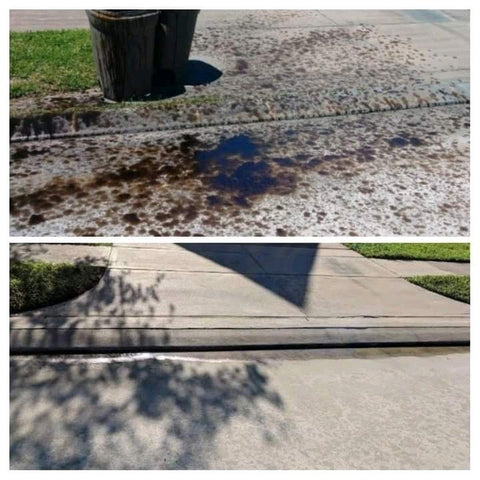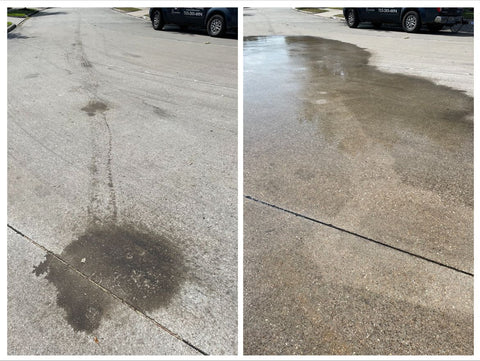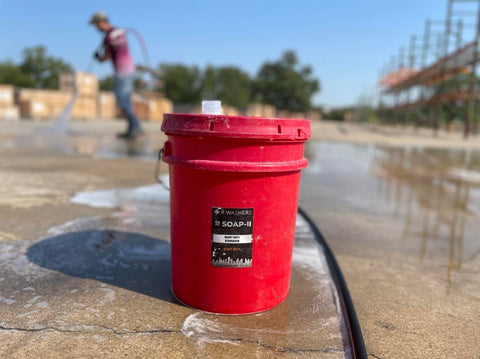
Soap List / Part III Concrete Cleaning
Share
R Soap II is a professional general purpose industrial strength degreaser that can be used for many applications.
R Soap II - Heavy Duty Degreaser
What makes R Soap II different from other soaps? It has the same cleaning capabilities as sodium hydroxide based cleaners but with half the caustic. Typically, you'd think you need a stronger mix to clean up grease, too much sodium hydroxide leaves behind lye, causing the concrete to get dirtier and slippery quicker, it attracts the dirt back to the surface. Less caustic in R Soap II, same cleaning capabilities! Great on petroleum and fatty grease too. Very effective for black foot traffic at restaurant establishments. R Soap II includes foaming agents, preventing the need of foaming boosters, leveling agents with chemical properties that allow the soap to travel deeper into the surface and penetrate the concrete.
Great for heavy-duty concrete cleaning, oil stain cleaning, garbage juice spills, hydraulic oil spills, degreasing, heavy equipment cleaning, tire marks, oil stains, dumpster pads, 2 step fleet washing.
R Soap II doesn't contain any acid and is a great acid neutralizer. Do not let it dry on the surface.
R Soap II is a caustic and should be handled with care. In the event it gets on your skin, rinse thoroughly with cold water so you don’t get a chemical burn from the sodium hydroxide contents within the soap.
Vent Hood Cleaning - No foam boosters needed. Mix anywhere from 3:1 - 10:1, let soak for 10-15 minutes then rinse.
Tire Marks & Oil Stains - 3:1, let soak for 10-15 minutes then rinse.
Dumpster Pads - 3:1, let soak for 10-15 minutes then rinse.
Standard Concrete Cleaning - 10:1 - 20:1, let soak 10-15 minutes then rinse.
Fleet Wash 2-Step (2nd Step Neutralize) Downstream 10:1, rinse right away, do not let dry on surface.
Heavy Equipment: (can damage paint) 5:1
Hydraulic Fluid - Works best if you can respond within 24 hours. If the spill is weeks old, the shadowing will still be left behind, no matter what chemical you use. Soaking up as much oil with litter or some sort of absorber will give you a better shot of not staining the concrete.
1:1 - 5:1
Cost Advantages
I’d like to break down the cost of it. If you’re getting a drum kit and you’re using it for standard concrete cleaning, mixing it 10:1, the cost per gallon is going to be right at five dollars a gallon. For every five dollars you have 1 gallon that covers about 150 - 200 ft.² If you’re just doing maintenance cleaning for gas stations, I know most of our customers will use 2 to 3 gallons per gas station cleaning so with the drum kit to do an average size gas station with eight stalls you’re going be somewhere between 10 and $15 per location. If you’re running hot water, most of these guys are using one to 2 gallons per location so your cost would go from $10 to $15 to $5 to $10 per location.
Mixing Instructions for the drum kit:
We recommend having a 55 gallon or larger container with a lid large enough to be able to stir with a paddle.
This comes in 2 five gallon pail containers.
- Pour your first pail, the powdered contents, in a container. Fill halfway with water and then stir the powdered contents until dissolved. The water will heat up.
- Pour the liquid contents in, stir, and fill the rest of the way with water. Note, we don’t use the blue dye in our kits, it will be a clear yellow solution.
Which is better, liquid or powdered soap? We believe people overuse the powdered version of caustic cleaners. Liquid solutions are able to have penetrating elements and leveling agents that you’re not able to get with the powdered caustic. Powdered cleaners break the surface grease off well but our liquid version will help bring more out of the pores of the concrete.
What removes tough grease? R Soap II Heavy Duty Degreaser
Before and After Photos and Videos:
Driveway Cleaning




